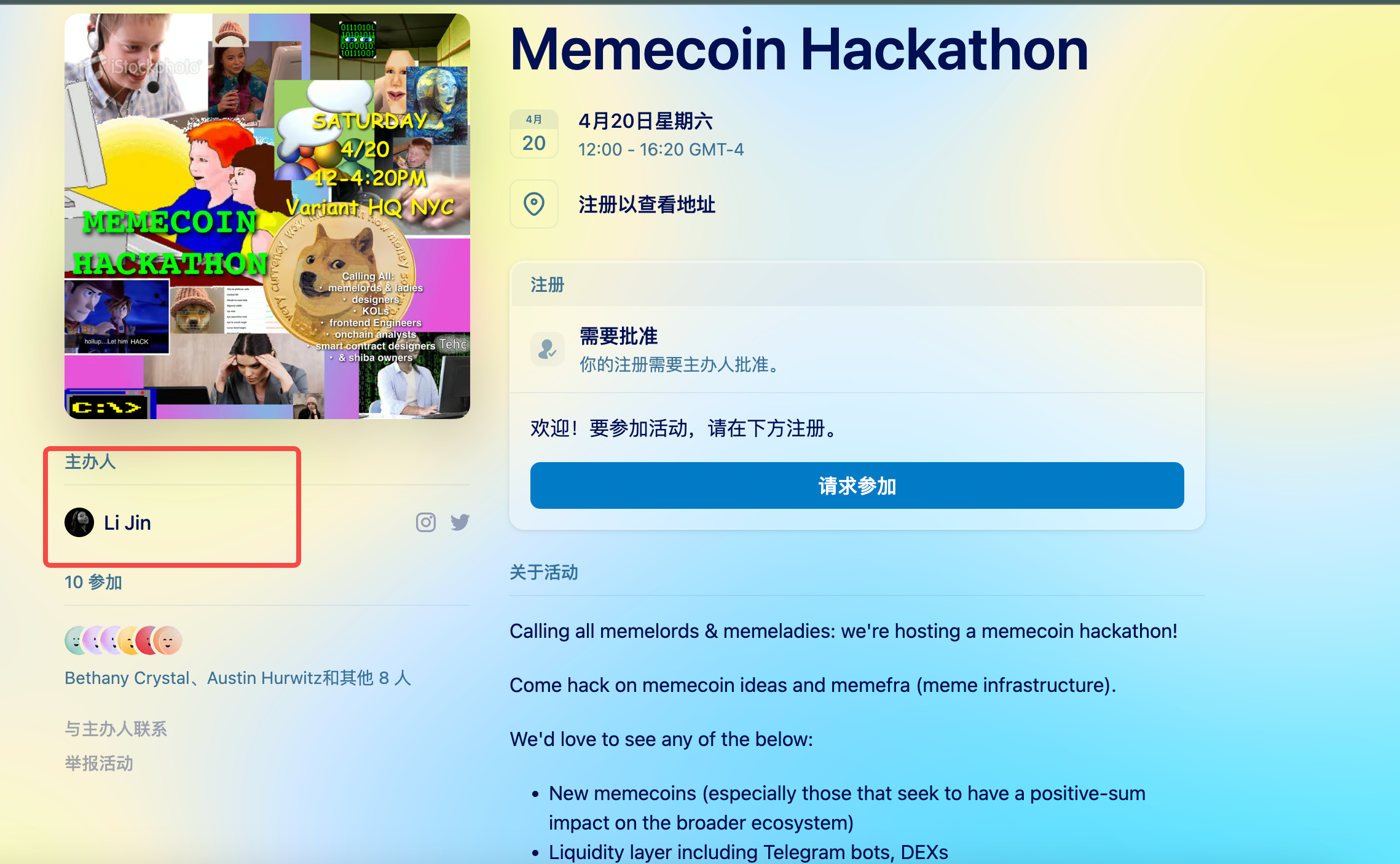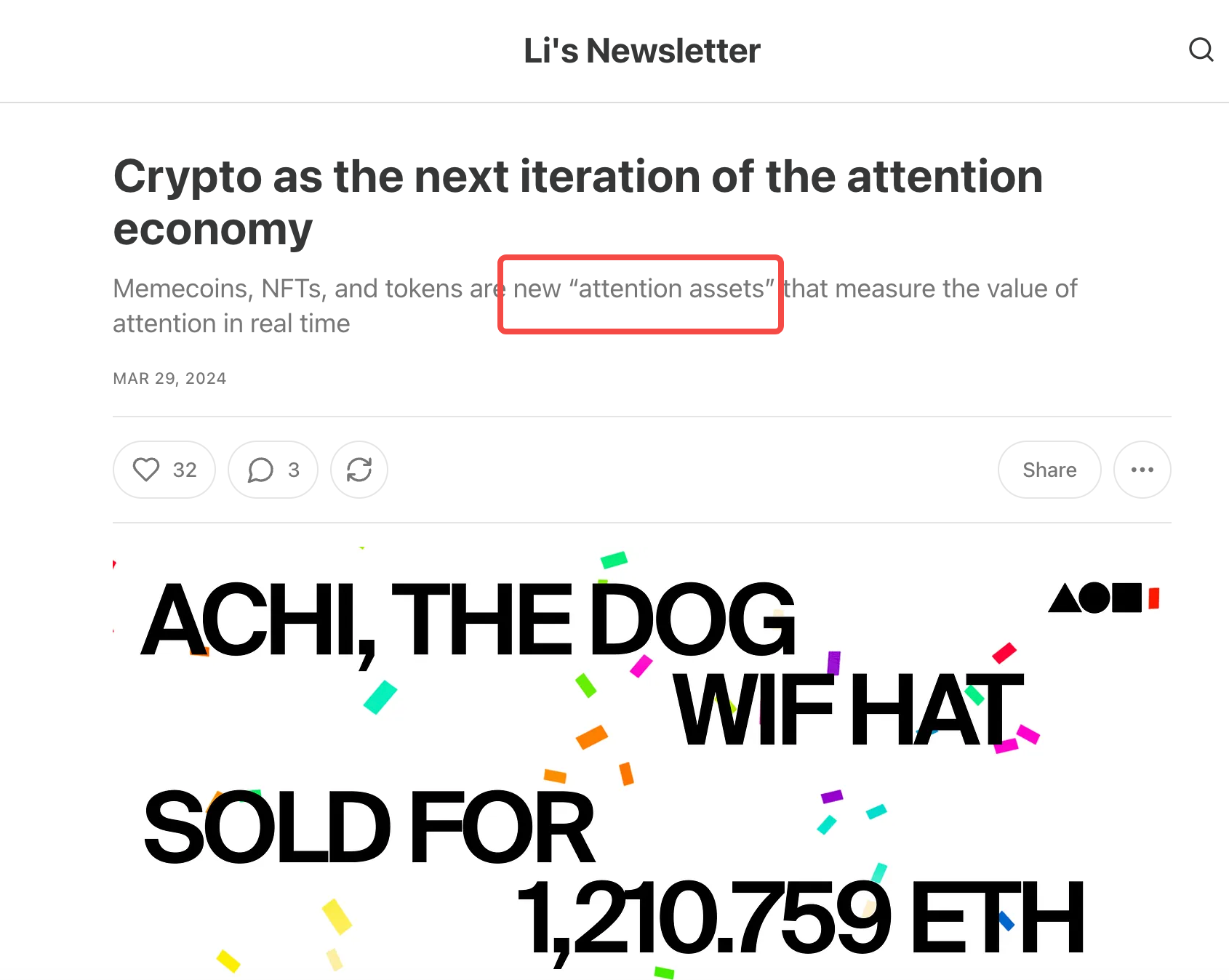Author: Deep Tide TechFlow
Usually in the eyes of retail investors, VC is the booster of the sickle, and Meme is the big red flag against the sickle.
Memes driven by culture and community often lack excessive primary investment and endorsement from major VCs. The relatively fair and random nature has gradually turned "retail investors" into a carnival of being cut in every way - it's better to bet on Meme lottery.
However, this carnival has not belonged to VCs for a long time.
VCs with top-notch foresight and vision naturally understand the shift in the wind in the crypto circle. Whether it's anxiety or contemplation, they have to do something to seek a breakthrough in the attention economy tidal wave.
Recently, Variant co-founder Li Jin has taken action and wrote on her Twitter:
"Born too late to explore the Earth; born too early to explore the universe; born at the right time, hosting a meme hackathon."

This event, called Memecoin Hackathon, with the organizer listed on the introduction page being Li Jin, is scheduled to be held at the headquarters of Variant Fund in New York on April 20, calling for teams that can build the following:
New meme coins, especially those seeking to have a positive impact on a broader ecosystem
Liquidity layers, including Telegram bots, DEX
Applications using memecoins as a go-to-market strategy
Applications building practicality around memecoins
It's interesting to note that the event mentions a term called "Memefra," which refers to Meme infrastructure. It's clear that VCs also welcome anything that creates conditions for Memes.
Born at the right time, VCs who have always pursued high-end infrastructure technology, are they really starting to catch up with the Meme wave with a native "retail investor" temperament?
Attention Economy, the perpetual motion machine of the crypto circle
In fact, VC co-hosting a Meme hackathon is not a sudden whim, but more of a timely move.
VC investment emphasizes value return, and Memes themselves possess "attention value."
In an earlier blog post by Li Jin, she keenly realized that Memecoins, NFTs, and tokens are new "attention assets" that can measure the value of attention in real time.

Abundant information leads to attention scarcity, making attention a scarce resource. However, in the Web2-dominated advertising business model, the value brought by user attention is harvested by the platform, not flowing to the users.
Therefore, cryptocurrencies can be seen as the next generation iteration of the attention economy, with a more efficient market.
Memecoins can measure and capture the value of attention in real time. Users can invest in and own attention assets, expressing their belief in whether specific memes, media, creators, or networks will receive more attention and interest in the future.
From this perspective, VC's favoring of Meme coins becomes more reasonable.
After all, successfully investing in products that capture the attention of the masses (even if it's a Meme) is quite tempting and persuasive.
While attracting user attention, the emergence of Memes has also taught many crypto projects a lesson in marketing methods and listing pace:
In the traditional model, crypto projects follow the path of "product first, then attention" - first build a product through technology, then gradually build a community around it through marketing, and make it known;
In the attention economy of Memes, crypto projects can completely "attention first, then product" - by launching a project integrated with a popular memecoin, new applications/infrastructure can mobilize the holders of memecoins, allowing them to experience more utility from their tokens.
The two different development paths clearly show that the times have chosen the latter.
Regardless of the type of crypto project, fundamentally, they are all about attracting attention, getting more people to participate and use, and creating a connection with the tokens.
Driven by the attention economy, the crypto circle has gone through many stages, from Bitcoin to Ethereum, from NFTs to Memes, each narrative shift represents a transfer of attention.
Therefore, it's not surprising that VCs are making changes in line with the attention, revolving around attention.
Users are educated by VCs, and users also educate VCs
However, you should know that the crypto market was not always dominated by the frenzy of Meme without a background, but rather followed a traditional and serious path of venture capital.
When Ethereum was just born in the early years, even Vitalik had to pitch and explain Ethereum to various investors from the East and the West in 2014.

Although many veterans in the crypto circle often reminisce about "no one understood Ethereum at the time, and now they regret not investing," even someone as strong as Vitalik, crypto projects have always followed an unchanged process:
First, impress VCs with strength (or bragging strength), then move towards the market to seize (or harvest) the attention of users.
In this path, whether it's ICOs or IEOs, VCs have gained a large number of low-priced chips in the early rounds, and then sold them based on different unlocking conditions when the project moved to the secondary stage; of course, there are savvy retail investors who followed suit, but there are also a large number of last-minute buyers.
Over time, users have become tired; after being educated for a round, they probably understand how things work.
So, we are increasingly able to see in the new cycle projects like inscriptions, runes, and Memecoins that VCs are not very involved in, are too late to participate, or disdain to participate. They have broken the traditional venture capital process and the path of attention growth:
First, directly impress users' attention with explosive growth, then do other things based on the user base.
Users are not afraid of the volatility, but afraid that I don't have a better opportunity to enjoy the volatility than you do, and it's clear that Memes have given users a relatively closer channel, even if they may be cut, it's still better than explicitly handing it over to VCs.
So, to some extent, users are also educating VCs, telling them that times have changed.
It's interesting to see a role reversal in the ecosystem, and this is exactly what makes the crypto circle interesting:
Mutual cutting and hurting, mutual growth.
免责声明:本文章仅代表作者个人观点,不代表本平台的立场和观点。本文章仅供信息分享,不构成对任何人的任何投资建议。用户与作者之间的任何争议,与本平台无关。如网页中刊载的文章或图片涉及侵权,请提供相关的权利证明和身份证明发送邮件到support@aicoin.com,本平台相关工作人员将会进行核查。




